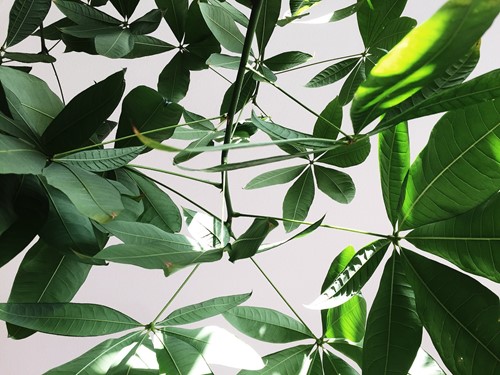Email: Lynn@LynnButterfield.com

Schefflera, also called umbrella plant, is a popular indoor tree. The plant gets its name from the whorl-like pattern of its leaves resembling the top of an umbrella. The vibrant, glossy foliage creates a dense canopy at heights up to six feet indoors. If you're interested in growing an umbrella plant at home, here are some basic tips:
Schefflera thrive in bright or filtered indirect light. It's best to provide at least four hours of light per day, but be careful not to let the leaves burn in harsh afternoon sunlight. South-facing windows or any window with a sheer curtain will be perfect for a healthy and fast-growing umbrella plant.
Umbrella plants do not like to dry out completely between waterings. Check the soil regularly to ensure it remains evenly moist but not waterlogged. Many plant experts opt for growing their umbrella trees in plastic growers pots inside of a decorative cache pot, as clay or terracotta can dry out the soil too quickly. Water thoroughly and make sure your choice of container has adequate drainage.
Schefflera thrive in average home temperatures but are very sensitive to cold. Protect your umbrella plant from temperatures below 55 degrees Fahrenheit and it will thrive. For humidity, most average household humidity levels will be enough to keep this plant happy. However, using a portable humidifier to maintain humidity of 60% or more will make for a happier plant.
It's important to note that umbrella plants are toxic to both humans and animals. If you have pets or small children, you may wish to consider an alternative indoor tree to remove any risk of poisoning. However, since the plant grows in a tree-like pattern with most of the foliage high up, it may be out of reach for pets or curious young children. Take special care to gather and dispose of any dropped leaves so they don't become a dangerous snack for your furry friends.

Lynn Butterfield is an Associate Broker at Coldwell Banker and is a Certified Real Estate Negotiator. Mr. Butterfield has 41 years of experience in real estate sales and development. His vast experience ranges from luxury sales through commercial sales and leasing. Perhaps more importantly, he focuses his attention on client success, whether he's helping someone buy their first home, or working with a developer seeking assistance to create and position a large project in the marketplace. One recent client said, "Working with Lynn is almost like working with a Real Estate Attorney, because he knows exactly what to look for, so you can be protected!" Another first-time home buyer just said, "I needed someone to hold my hand through this because it's the largest investment we'll ever make! I know he isn't in this just to make a quick buck. He really cares about his clients!"
Whether you're in the research phase at the beginning of your real estate search or you know exactly what you're looking for, you'll benefit from having a real estate professional by your side. He would be honored to put his real estate experience to work for you.